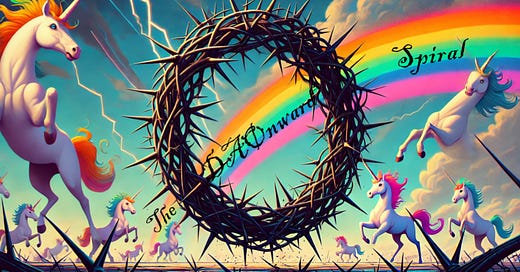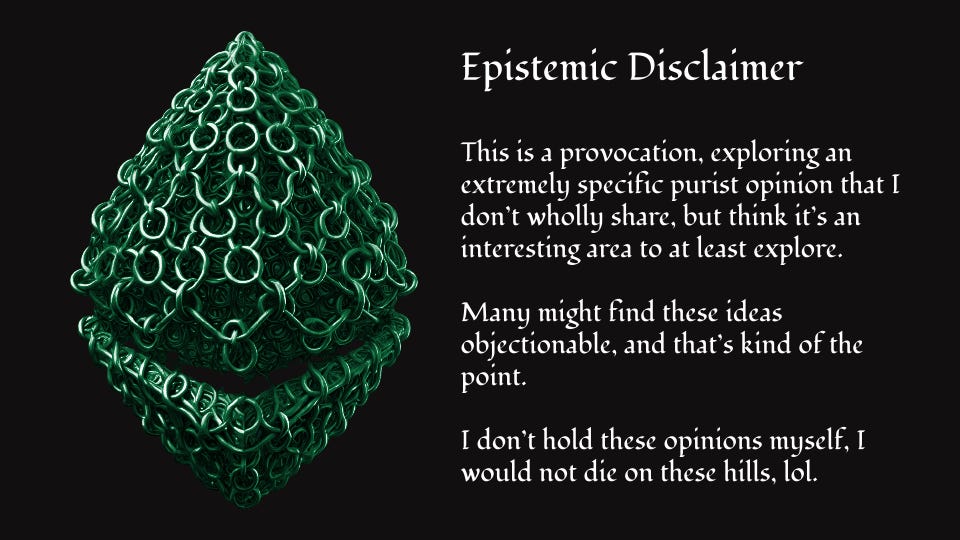ṣifrpunk (صفربانك): Much Ado About Nothing?
Why, despite the desires within its community, Ethereum will probably never achieve its 'Cypherpunk' aspirations. But here's something it can be instead.
Note: this piece is based on a somewhat underprepared presentation I gave at the Ethereum Cypherpunk Congress in Bangkok in November ‘24. I’ve taken the transcript from the video, tidied it up, and dropped in some of the slides to illustrate the points I’m trying to make.
It is intended as a provocation rather than a set of beliefs I hold strongly.
No Naught November
The above disclaimer — in part confession, in part dare — opened my recent talk at the Ethereum Cypherpunk Congress in Bangkok, on the side of last year’s Devcon. Over the past decade, I’ve orbited the blockchain space, observing phenomena, analysing networks, predicting outcomes, and critiquing contradictions. This time, the idea is to trace a thread through Ethereum’s early history: from the idealism of “code is law” to the grim reality of implicit power, schisms, and Machiavellian politicking.
The blockchain space thrives on grand narratives, and we’re all doubtless sick to death of hearing them by now: decentralization, autonomy, trustlessness, blah. Be your own bunk. Yet beneath the tired rhetoricisms lie systems that — due to a mix of naïve design, careless implementation, and (let’s be honest) malign intentions — replicate the hierarchies they claim to dismantle. To paraphrase Audre Lorde:
the master’s private key will never dismantle the master’s house.
The cypherpunk dream of the late 20th century is alive and well in some of the community constellations that orbit Ethereum.1 But it’s another matter as to whether reality meets these idealistic expectations. To understand how and why we ended up where we are, we will first undertake an etymological journey from today’s word cipher and its journey through time, space, and thought.
Post-Naught Clarity
The word cipher — which Jude Milhon bastardised with cyber to arrive at cypher —derives from the Arabic ṣifr (صفر), referring to the number zero. The concept of zero as a computable entity rather came from South Asia, with the Sanskrit word for nothing-void, śūnya (शून्य), traced back as far as ~250 BCE. From around 300 CE a dot was being used as placeholder — to distinguish, for example, 14 from 1004 — and by 500 CE zero was a number in our modern sense of the concept. Arabs “visited” present-day India, and brought much mathematical and astronomical knowledge back with them as spoils of war. Sites of scholarship such as Baghdad’s House of Wisdom (بَيْت الْحِكْمَة) became unparalleled concentrations of scholarship in the Islamic Golden Age, where Muhammad ibn Musa al-Khwarizmi laid the foundations for modern mathematical and computational paradigms such as algebra and algorithms (which take their name from him). Earlier still, there is evidence of Mayan and Babylonian systems using dot-as-placeholder, acknowledging the significance of absence, but it is difficult to conclusively trace diffusion of these ideas between lands and cultures.
By the 13th century, Fibonacci and others borrowed ṣifr into Latin via Greek: zephyrum, zephyrus, zephyr, zephiro, and ciphra eventually gave us zero and cipher.
Hashes to Hashes, Trust to Trust.
It seems somewhat poetically apropos that zero and cipher share the same linguistic roots. In many ways, the envoidened nothingness of zero represents the aspirations of the cipher: to cloak, to hide, to render illegible. Let’s not overlook the etymology of crypto itself:2 the Latin crypta (for vault), ultimately derived from Ancient Greek κρυπτός (kruptós, “hidden”). For the cypherpunks, who were dedicated to using strong cryptography to uphold personal freedoms and liberties, the desire for hiddenness was to be achieved through the envoidening capability of the cipher, manifested through practical techniques such as encryption and hashing. But, zero is more than a mere numeral. At the origin point, occupying the interstice between positive and negative domains, it connotes negation, absence, and incongruity. In medieval Europe, zero was seen as a destabilising force.
Capitalism’s Transcendental Paperclip Machine
What does a browser game about office supplies tell us about Ethereum? In Universal Paperclips, players start as humble artisanal stationery crafters, before escalating rapidly into hyper-dimensional AI overlords strip-mining the universe for all available material. The game’s lesson? Unchecked optimisation functions — whether in markets or persistent programmatic substrates — cannibalise ethics as sacrificial offerings for the upaya of growth. Machiavellian Extractable Value.
Here’s a quote from Jean Baudrillard’s Symbolic Exchange and Death:
“we now live in a world dominated by the free play of the ‘monetary sign’ that is beyond reference to any ‘real’ of production or even a monetary referent in the form of a gold standard. In this world, the idea of a ‘real’ value (of equities, of commodities, of houses, of anything) is meaningless as what matters instead is not value per se but infinite speculation…this new world is marked by the emergence of a ‘brothel of capital…not for prostitution, but for substitution and commutation.”
Jean Baudrillard, ‘Symbolic Exchange and Death: Revised Edition’, tr. Mike & Nicholas Gane, Theory, Culture & Society, 1976.

It’s no great leap to notice that Baudrillard’s brothel of capital is alive and well in decentralised finance (DeFi). Automated market makers, yield farms, perpetual swaps, and memecoins are not tools for liberation they were purported to be, rather algorithmic slot machines at best, spinning ever-faster to feed liquidity’s insatiable hunger. Devcon’s ‘Infinite Garden’ theme — much-derided for its conceptual naïveté and tired aesthetic tropes3 — feels ludicrous when the only thing left alive in the soil are speculative Rube Goldberg machines that have scorched the very Earth they extract from. The Degens have taken over the asylum, leaving little space for any other ideological bent in Ethereum at the grassroots level, and even the lengthy screeds by Dear Leader are increasingly interspersed and bookended with rightcoded references to edgelordists4 that couldn’t be further away from any kind of worthwhile ideal to espouse.
Universal Paperclips’ finale, as a universe reduced to a primary school rendition of medieval chain-mail armour — mirrors Ethereum’s (cru)sad(e) trajectory. When the only metric is growth, everything else is ground into dust. Goodhart’s law as a runaway chain reaction. Even the non-negotiable privacy ideal of the cypherpunks is still a distant dream on Ethereum: it’s been ten years and people still have vanity addresses linked to their asset holdings. Whenever a privacy-enhancing service comes along, the operators are put in jail. In 2018, I shared the stage at a conference with someone that used to direct Special Projects at EF, who went (and is still in afaik) jail for visiting North Korea and “sharing technology” with a pariah regime.
The Cathedral and the Bizarre; The Preuß of Anarchy; The Τυῤῥηνοί of Stricturelessness
The “Cathedral and the Bazaar” metaphor, coming out of a libertarian corner of open-source software circles, pits collaborative, peer-to-peer development (the bazaar) against centralised, top-down control (the cathedral). This black-and-white reduction is of course insufficient for the infinite shades of grey we find in the contemporary condition. It’s easy to say p2p bazaar good, hierarchical cathedral bad. What we see in reality is that explicit, rules-based verticality is substituted for implicit, norms-based variants should we choose to portray ‘our graph’ as more egalitarian. In essence, every bazaar has encoded within it yet another cathedral. So much ink has already been spilled on the shadow power structures in every crypto-network — including by my fair hand5 — that I’m sure you can find your own way to discussions about the power that Bitcoin or Ethereum ‘core developers’ have, much of which I have to add is argument in bad faith, i.e. “my cathedral should be in charge, not theirs”.
Let’s invoke the concept of the Price of Anarchy, a concept from game theory. We need to twist the concept a little to fit into this context, as PoA assumes an absence of selfish behaviour, which, as you probably have gathered by now, is an ideal I don’t think can be invoked in these contexts. To put it mildly. So instead, let’s think about PoA in terms of the presence and absence of formal hierarchical coordination mechanisms. Then there’s the Tyranny of Structurelessness, Jo Freeman’s feminist critique of horizontal organisation. Without formal hierarchies, informal ones emerge such as cliques, influencers, whales. In DeFi, “governance tokens” purport to democratise decision-making. In practice, they consolidate power among early adopters and institutional players. The aesthetics of decentralisation, without the architecture, is merely another mask that the same old master wears.
Here’s the abstract of the as-yet-unpublished 2018 book mentioned above, let me know if you’d like to read more.
Dictators, Cartels & Pyramids: Insider Asymmetries in Monetary Peer-To-Peer Networks
The focus of this work is to relate the asymmetric advantages enjoyed by ‘insiders’ observed throughout human society - encapsulated most widely as the agency problem in economic theory- with those being observed in tokenised peer-to-peer networks. This project brings the gravity of the varying governance issues being experienced in all open cryptocurrency and blockchain-archtected networks to the forefront and will encourage public debate on the matter. There is no formal research in the field to date that has uncovered the novel “social attack vectors” that are being explored in this work. The intended audiences are both the cryptocurrency ecosystem participants and stakeholders (as defined below) and also the wider public, media, regulators, lawmakers, politicians and investors. The ensuing debate over possible courses of action intended to ameliorate inequality of outcome and opportunity present in today’s cryptocurrency protocol networks will be of wide significance. This information is of sufficient magnitude and urgency that lead developers on major cryptocurrency projects have come forwards citing instances of chronic governance failures through informal channels and calling for public debate. Decentralised Autonomous Organisations (DAOs) are proposed as potential mechanisms by which inherent asymmetries in P2P networks may be mitigated.In every resource ecosystem - commoditised or otherwise - there exists the potential for imbalances, unfairness and asymmetry of information, capital and influence. Much work has been done in the realm of legacy finance and economics to model, predict, parameterise and rationalise the contributing factors and implications of such heterogeneities. Within the emerging analysis of open P2P cryptocurrency networks, the nature of trust-minimised distributed digital ledgers employing blockchain-type architectures allows for objective analysis of network traffic, token distribution and observation of explicit power structures within the network. Stakeholder constituents within these networks such as miners/producers, developers and node operators are effectively imbued with the authority to partake in network activities such as coin mixing, network software management, transaction routing, validation or block creation. Further there may exist a series of shadow power structures, facilitating control of aspects of a cryptocurrency network by a cabal of powerful insiders who may exercise a disproportionately large amount of influence over the path that the network in question may face through the media of in-protocol or extra-protocol governance mechanisms. This work explores amongst other phenomena, the emergence of a “Social Sybil” asymmetric governance vector whereby striated cadres of network insiders (developers, marketeers, miners) gradually consolidate effective power and influence by arbitraging or gaming the existing protocol governance mechanisms using intimate knowledge of their function.
Blockchains constitute distributed data structures which are typically sequenced temporally for the purposes of record-keeping with increased transparency, verification, finality, auditability and tamper-evidence with respect to hierarchical databases more commonly encountered. As such, shadow power structures in a blockchain-architected cryptocurrency must behave in a more clandestine manner in order to effect influence without making their activities and techniques evident. Such an imbalance in the stakeholder power structures may be concealed through the surreptitious exploitation of insider information asymmetry and may act as a tool of subterfuge constituting decentralisation theatre should attempts be made to obfuscate the inequality in network influence, control and concentration in order to maintain a pretence of valuable characteristics such as censorship-resistance, unconfiscatability, immutability or tamper-evidence. Initial investigations in this early-stage project has uncovered incontrovertible evidence of power structures in cryptocurrency networks corresponding to historical analogues of personality cults, technocracies, striated structures similar to India’s caste system, de facto cartels and effective dictatorships.
How Soon Is DAO?

The cornerstone of my ṣifrpunk presentation in Bangkok was the now seemingly memoryholed 2016 exploit of “The DAO”, which coincidentally was one of the main triggers for my first scholarly article on these topics in 2018. Back then, I was trying to invoke the network schisms — “forks” in disciplinary parlance — as a means with which to engage in comparative data science and epistemology, so as to make reasoned judgments about the possible futures of such networks.
The community’s response? A “Carbon Vote” where token holders weighted by stake decided whether to intervene. Critics called it gerrymandered; whales dominated the outcome. The fork passed, birthing Ethereum (pro-intervention) and Ethereum Classic (anti-intervention). The actions taken by the denizens of the Ethereum community — in essence, deleting the exploiter’s spoils — were rightly decried as censorship by many, and considered by the “code is law”6 camp to be a violation of the very conceptual bedrock of blockchain technology. No rulers, only rules, and definitely, definitely, no backsies.
The “Carbon Vote” — a coin-weighted referendum — manufactured consent for the intervention. But, as with so many gestures towards democracy, the process was fsr from perfect. Less than 5% of Ether holders participated in what was framed as a non-binding plebiscite, with whales dominating the outcome. We have always known that one-token-one-vote is a direct line to plutocracy. Detractors called it a “decentralised dictatorship”, and the pro-intervention demagogues argued the fork was a one-time exception. And so, with the censorious ṣifrpunks winning out over the cypherpunks, the deed was done.
Ethereum Classic, the unadulterated chain, became a cautionary tale in itself. Its “code is law” credo collided with reality when 51% attackers rewrote its history in 2019 and 2020. The chain’s minority hash rate made it vulnerable, and the community’s post-mortem calls — which I was invited to, after predicting what would happen at their conference a year prior — resembled a 10-man decision-making-cum-group-therapy session. The DAO hack was more than a technical failure. It was a metaphysical crisis. If blockchains are “unstoppable,” why do humans keep stopping them?
Coinclusionary Remarks
The church and the network
Zeal and time
Death and money
All sides of the same Coin.
The Black Hole of Money, 0xSalon, 2022.
Ethereum’s originally desired values and virtues — decentralisation, transparency, fairness, autonomy, frontierness, unstoppability — remain noble when considered in the abstract. Back in the real world, the gap between the ideal and the real — a Dante’s Entfernung, we might say — grows ever larger: as crypto-networks scaled and became co-opted into the hegemonic structures of finance and politics, they increasingly replicated the power structures they set out to overcome. The DAO exploit, cults of personality, and insider cartels are all symptoms of a deeper rot: the techno-optimistic belief that technology can transcend human frailty. Long ago, it was time to stop pretending blockchains are neutral, credibly or otherwise. These shiny techno-monoliths are largely mirrors, reflecting both humanity’s best ambitions and worst instincts. The cypherpunk dream may still be worth fighting for, with Bitcoin if not anywhere else. But first, we must reckon with the forces that pull us back into the old, old ṣifrpunk — and sufferpunk, even — machinations of humans. Only then, will the reactionary degenerates find their way to the Promised Land of the infinite garden, where abundant and optimistic sapphirepunk futures await.
I’m sure someone by now will have already demanded that Bitcoin is mentioned. Don’t worry ETHbro, though there isn’t space here for that, why not take a look at this previous missive.
This is quite a funny thing for me to write here, since every two-bit blockchain thinkboi is constantly talking about getting back to the “the roots of crypto”, but what they’re invariably talking about is pumping and dumping tokens with names like DentaCoin, HarryPotterObamaSonic10Inu, and Mutant Ape Yacht Club with no legal consequences.
I thank EF for including me in its 2024 Devcon Scholars artist track as a sci-fi writer, but someday (not today) I will write about the absolute disaster that the implementation of that program was. I have never been so bearish on the future prospects of the network that I am having seen the malignment issues inside the Ethereum Foundation. (This footnote was written before management changes at EF were announced).
I will, hopefully, get around to polishing up and publishing in these pages the unfinished 2018 monograph on “Dictators, Cartels, and Pyramids in P2P Monetary Networks”. Suffice it to say, nobody wanted to publish or fund it then, and dishearteningly little has changed in the intervening years.
I don’t really want to open the “code is law” can of worms here, but if you like you can watch an entire lecture about that I gave at the New Centre for Research and Practice a while ago.











